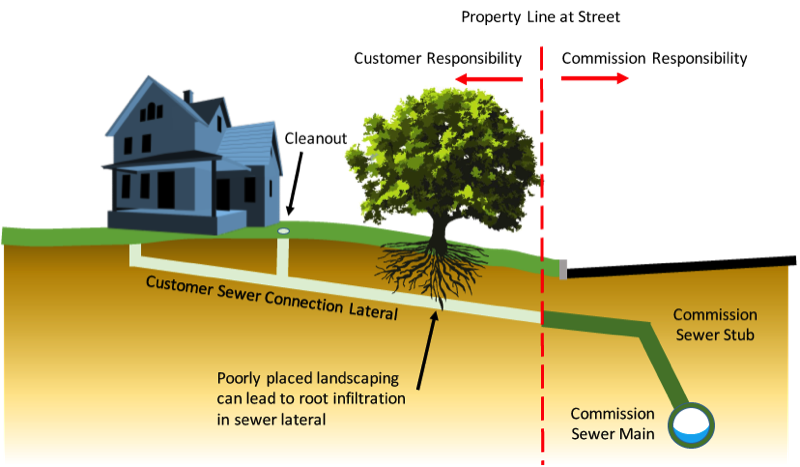Your Connection
Although customers know that they have a connection very few think about their connection or limits of their responsibility until they have a problem.
The connection from your property to the LSDC's sewer system is an expensive and important piece of your property's infrastructure. The "lateral" sewer line connecting your property to the main sewer line in the street is the responsibility of the property owner. As a property owner, you are responsible for ensuring the proper maintenance and function of this lateral. Your sewer lateral is generally a reliable low maintenance part of your property. However, if it does fail or backs up it can be very costly to repair and replace.
If you are planning on buying a home connected to the sewer it is recommended that you additionally get a report on the condition of the house's lateral connection.
Understanding what you own and are responsible for
LSDC Customers are responsible for building and maintaining the lateral connection from their house plumbing to the sewer main as well as any other associated elements like interior lift or grinder pumps. Like any other element of your property, you should care for and protect your sewer lateral.
Your sewer lateral is typically installed between the main plumbing pipe in your house in a direct line to the LSDC sewer main. In most cases, a cleanout will be installed either inside or outside of the foundation with additional cleanouts installed at intermediate points for longer connection. These cleanouts allow you to flush out your sewer line should it ever become clogged.
The leading causes of public sewer spills are roots and cooking grease. Property owners should be mindful when placing landscaping to ensure that the sewer lateral is not within the root zone of any trees and shrubs. Roots will seek out nutrient and water sources and will eventually find their way in to nearby sewer laterals. They will grow into and separate pipes eventually causing your connection to become clogged and fail.
Maintaining your sewer lateral, keeping it clean and open, can save you a great deal of money in plumbing and cleaning bills, and eliminate the aggravation a sewage backup will cause.


What to do if your plumbing fails
Frequently when plumbing fails, it is the result of a clog within your internal house plumbing or lateral which causes a backup.
Backups are when a plumbing fixture in your home drains slowly or is stopped up completely. A backup usually will not cause damage if you stop using the backed-up sink, tub or toilet until the system is cleared. Just turn off the water. While a backup can cause inconvenience, it is unlikely to cost a homeowner much more than a plumber’s call.
Failures and clogs within the sewer main do happen but are very rare and in most case lead to sewer overflows in the street before a backflow occur on private property. Sewer overflows onto private property can happen and when they do they are known as backflows. A backflow occurs when wastewater flow in the sewer main is blocked and fills up the main and eventually starts to flow into the house. Backflows can occur but are typically limited to low lying areas at the end of a line, bottom of a hill, or near a pump station.
If a backup does occur and there is no evidence of a sewer overflow in the street you should call a licensed plumber to troubleshoot your plumbing and connection. A plumber will flush out or snake the line and determine if there is any obstructions. If there is a blockage in the service line cannot be cleared by the plumber then the Customer should contact the LSDC to evaluate the sewer main. We will send an inspector out to survey the main and determine where the problem is.
If the LSDC determines that the sewer main is blocked then the LSDC will make repairs or unblock the main to restore service. However, if the sewer main is clear and free flowing the customer must hire a contractor to repair the sewer lateral. Permits are required for sewer lateral repairs but will be issued on an expedited emergency basis if necessary.
If not repaired a backup or a backflow can cause serious damage, including flooding a room or an entire home. The cost of restoration after flooding and the hassle of dealing with insurance can be a major headache for property owners.
If a backup or backflow causes flooding in your home:
• Keep people and pets away from the affected areas.
• Do not attempt to clean it yourself.
• Turn off heating and air-conditioning systems and prevent flow from reaching floor vents by using towels or blankets.
• Call an experienced restoration company for cleanup and removal of affected surfaces.
• Leave items in the affected area for the experts to handle.
• Report a claim to your homeowner’s insurance.
• If you had recent plumbing work, contact your plumber or contractor.
• If you have a claim against the District, file your claim as soon as possible.
Typical Sewer Connection
Avoiding blockages and maintaining your connection
Most major blockages can be avoided through simple prevention. The two most effective things you can do to avoid blockages is to avoid planting any trees or shrubs near your lateral and avoiding putting anything down your drain that can lead to clogs.
Plan your landscaping so that any root systems from trees and shrubs is a safe distance away from your lateral. Depending on the species of tree involved, the “safe” distance from your lateral varies. For example, roots of some Poplar and Willow trees have been known to reach into sewer lines nearly 100 feet away. Tree roots tend to grow towards sources of water – including sewer pipes. If you are making additions to your home’s landscaping, you can save yourself headaches and money by choosing trees with deeper root systems. In particular, avoid planting trees with shallow, spreading root systems near your lateral.
Making sure that the right things go down your drain can sometimes be a little less clear cut.
Many sanitary sewer backups and clogs are caused by excessive Fats, Oils, and Grease (FOG) being improperly disposed of. The majority of FOG blockages occur when cooking oils and grease are disposed of down the drain and coat the inside sewer pipes. The LSDC has adopted a Fats, Oils, and Grease (FOG) policy intended to provide residents and business owners with the proper tools and knowledge needed to prevent sanitary sewer pipe blockages that cause backups and sanitary sewer overflows.
Keeping your sewer lateral in good shape
• Never pour cooking grease down the drain. Freeze it in a suitable non-recyclable container and dispose of it in the trash.
• If any cooking oil or grease gets in your drain, immediately flush the drain with cold water.
• Never flush non-soluble objects down your toilet. This includes diapers, tampons, sanitary napkins, cleaning rags, etc.
• Use a commercially available rooticides and move landscaping if you have problems with roots infiltrating your lateral.
• If you have a property cleanout, flush your lateral through the cleanout using a high pressure hose at least once a year.
• Be sure to use a licensed plumber when having your sewer lateral televised or repaired.
